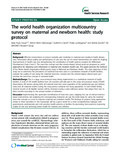The World Health Organization multicountry survey on maternal and newborn health: study protocol

View/
Date
2011-10-26Author
Souza, João P
Gülmezoglu, Ahmet M
Carroli, Guillermo
Lumbiganon, Pisake
Qureshi, Zahida
WHOMCS Research Group
Type
Journal ArticleMetadata
Show full item recordAbstract
Abstract
Background
Effective interventions to reduce mortality and morbidity in maternal and newborn health already exist. Information about quality and performance of care and the use of critical interventions are useful for shaping improvements in health care and strengthening the contribution of health systems towards the Millennium Development Goals 4 and 5. The near-miss concept and the criterion-based clinical audit are proposed as useful approaches for obtaining such information in maternal and newborn health care. This paper presents the methods of the World Health Organization Multicountry Study in Maternal and Newborn Health. The main objectives of this study are to determine the prevalence of maternal near-miss cases in a worldwide network of health facilities, evaluate the quality of care using the maternal near-miss concept and the criterion-based clinical audit, and develop the near-miss concept in neonatal health.
Methods/Design
This is a large cross-sectional study being implemented in a worldwide network of health facilities. A total of 370 health facilities from 29 countries will take part in this study and produce nearly 275,000 observations. All women giving birth, all maternal near-miss cases regardless of the gestational age and delivery status and all maternal deaths during the study period comprise the study population. In each health facility, medical records of all eligible women will be reviewed during a data collection period that ranges from two to three months according to the annual number of deliveries.
Discussion
Implementing the systematic identification of near-miss cases, mapping the use of critical evidence-based interventions and analysing the corresponding indicators are just the initial steps for using the maternal near-miss concept as a tool to improve maternal and newborn health. The findings of projects using approaches similar to those described in this manuscript will be a good starter for a more comprehensive dialogue with governments, professionals and civil societies, health systems or facilities for promoting best practices, improving quality of care and achieving better health for mothers and children.
URI
http://dx.doi.org/10.1186/1472-6963-11-286http://erepository.uonbi.ac.ke:8080/xmlui/handle/123456789/14698
